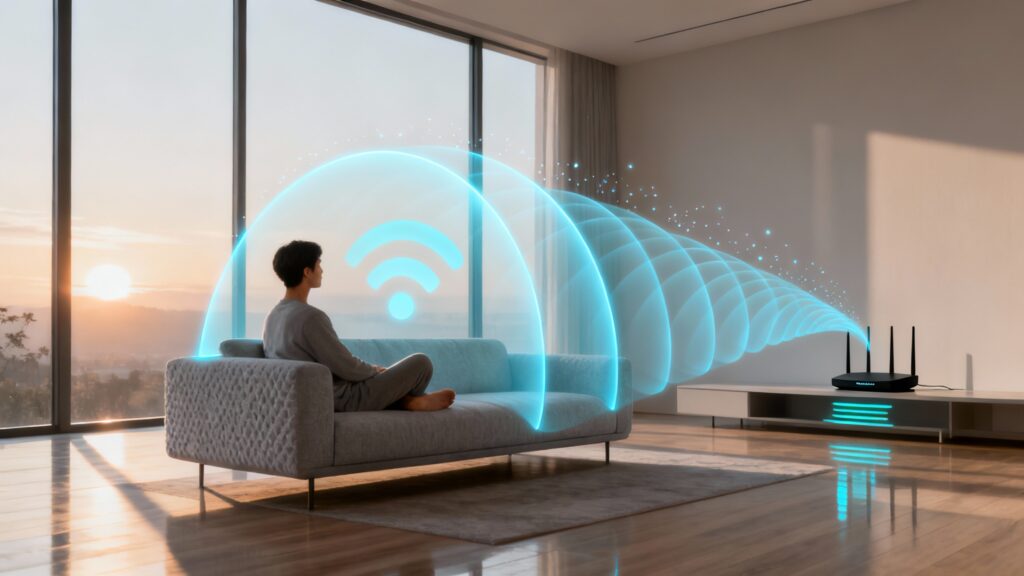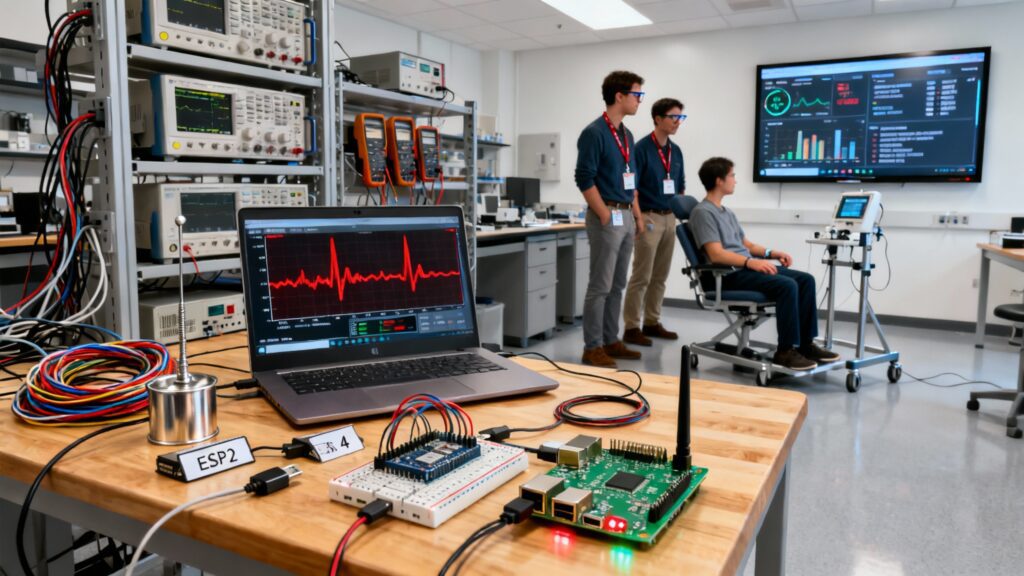
The future of health monitoring has arrived. It doesn’t require smartwatches, chest straps, or any physical contact with your body. Instead, it uses something already present in millions of homes worldwide: Wi-Fi signals.
Researchers at the University of California, Santa Cruz have developed groundbreaking technology called “Pulse-Fi” that can accurately measure your heart rate using ordinary Wi-Fi signals. This innovation promises to revolutionize how we monitor vital signs, making healthcare more accessible and less intrusive than ever before.
The Science Behind Wi-Fi Heart Detection
Wi-Fi devices constantly emit radio frequency waves into the physical space around them. These waves travel toward receiving devices like computers and phones. As they pass through objects in their path, some of the wave energy gets absorbed, creating mathematically detectable changes in the signal.
The human heart creates subtle movements in the chest cavity with each beat. These tiny motions are enough to alter Wi-Fi signals in measurable ways. Pulse-Fi technology captures these minute variations and uses advanced machine learning algorithms to distinguish heartbeat patterns from other environmental noise.
“The signal is very sensitive to the environment, so we have to select the right filters to remove all the unnecessary noise,” explains Nayan Bhatia, a Ph.D. student in Computer Science and Engineering who helped develop the system.
The technology works by combining a Wi-Fi transmitter and receiver with sophisticated signal processing algorithms. The system filters out interference from movement, environmental changes, and other sources to isolate the faint signatures left by heartbeats.
Remarkable Accuracy in Real-World Testing
The research team conducted extensive testing with 118 participants to validate their system’s effectiveness. The results were impressive. After just five seconds of signal processing, Pulse-Fi could measure heart rate with clinical-level accuracy, showing only half a beat-per-minute of error.
Longer monitoring periods increased accuracy even further. The system maintained its precision regardless of the person’s position or activity level. Whether participants were sitting, standing, lying down, or walking, Pulse-Fi delivered consistent results.
The researchers tested 17 different body positions with each of the 118 participants. In every case, the system accurately detected heart rates. This versatility makes the technology practical for real-world applications where people move naturally throughout their day.
Distance proved to be no barrier either. The system worked accurately with people positioned three meters (nearly 10 feet) away from the hardware. Further unpublished testing shows promising results for even longer distances.
“What we found was that because of the machine learning model, that distance apart basically had no effect on performance, which was a very big struggle for past models,” notes Pranay Kocheta, a high school student and visiting researcher who contributed to the project.
Ultra-Low-Cost Implementation
One of Pulse-Fi’s most compelling advantages is its affordability. The researchers achieved their breakthrough results using ultra-low-cost ESP32 chips, which retail for just five to ten dollars. Raspberry Pi devices, costing around thirty dollars, delivered even better performance.
This cost-effectiveness opens doors for widespread deployment, especially in resource-limited settings where expensive medical equipment isn’t feasible. More expensive Wi-Fi devices found in commercial routers would likely improve the system’s accuracy further, but the basic functionality works with remarkably inexpensive hardware.
The team’s approach democratizes health monitoring technology. Instead of requiring specialized medical devices or expensive wearables, Pulse-Fi transforms everyday Wi-Fi equipment into sophisticated health monitoring tools.
Overcoming Traditional Monitoring Limitations
Current heart rate monitoring methods face significant challenges. Wearable devices can be uncomfortable and suffer from poor user adherence. Many people find smartwatches bulky or forget to charge them regularly. Hospital-grade equipment is expensive and requires trained operators.
Camera-based contactless monitoring systems exist but have serious limitations. They struggle in poor lighting conditions and raise privacy concerns since they require visual access to the person being monitored.
Professor Katia Obraczka, who led the Pulse-Fi development, emphasizes the importance of continuous vital sign monitoring. “Continuous tracking of vital signs, including heart rate, can help flag health concerns such as stress, dehydration, cardiac disease, and other illnesses,” she explains. “But using wearables to monitor vitals can be uncomfortable, have weak adherence, and have limited accessibility due to cost.”
Pulse-Fi sidesteps these issues entirely. It requires no physical contact, works in various lighting conditions, and doesn’t compromise privacy since it doesn’t capture visual information.
Advanced Machine Learning Makes It Possible
The key to Pulse-Fi’s success lies in its sophisticated artificial intelligence model. The researchers needed to train their machine learning algorithm to distinguish the extremely faint Wi-Fi signal changes caused by heartbeats from all other environmental variations.
No existing dataset contained the specific patterns they needed for ESP32 devices, so the team created their own. They set up their system in the UC Santa Cruz Science and Engineering library alongside standard pulse oximeters to gather “ground truth” data.
By combining data from the Pulse-Fi setup with verified heart rate measurements, they taught a neural network to recognize which signal changes corresponded to actual heartbeats. The AI model learned to filter out noise from movement, environmental changes, and other sources while preserving the subtle heartbeat signatures.
The machine learning approach proved remarkably adaptable. The system works effectively in new environments that weren’t part of its training data. “The model generalized well in [a new] setting, showing it’s not just memorizing, but actually learning patterns that transfer to new situations,” Obraczka notes.
Breakthrough Research Methodology

The development of Pulse-Fi required innovative research approaches. The team conducted two distinct experimental phases to validate their technology. The first experiment involved seven volunteers positioned at varying distances from ESP32 microcontrollers. Participants sat at one, two, and three-meter distances while the system estimated their heart rates.
These measurements were continuously compared against pulse oximeter readings to ensure accuracy. The controlled environment allowed researchers to fine-tune their algorithms and understand how distance affected performance.
The second experiment expanded the scope dramatically. More than 100 participants engaged in various activities including walking, running in place, sitting, and standing. This comprehensive testing revealed the system’s robustness across different physical states and movements.
The research methodology also incorporated data from Brazilian researchers who had created an extensive dataset using Raspberry Pi devices. This collaboration provided additional validation and demonstrated the technology’s effectiveness across different hardware platforms.
Real-World Applications and Future Potential
Pulse-Fi opens up numerous practical applications across healthcare and wellness monitoring. The technology could enable continuous health monitoring in homes, offices, and healthcare facilities without requiring patients to wear any devices.
Elderly care facilities could monitor residents’ vital signs continuously without the discomfort or compliance issues associated with wearable devices. Hospitals could track patients’ heart rates in real-time without additional equipment costs.
The technology also shows promise for detecting other health conditions. The research team is already working on extending Pulse-Fi to monitor breathing rates, which could help identify sleep apnea and other respiratory conditions. Unpublished results show high promise for accurate breathing rate and apnea detection.
Home health monitoring represents another significant opportunity. Families could monitor loved ones’ vital signs remotely, providing peace of mind and early warning of potential health issues.
Technical Innovation Meets Practical Deployment
The Pulse-Fi system represents a perfect marriage of advanced technology and practical implementation. The underlying science is sophisticated, involving complex signal processing and machine learning algorithms. Yet the end result is remarkably simple to deploy.
The system can run on basic computing devices like Raspberry Pi units, making it accessible to a wide range of users and applications. The AI model processes signals in real-time, providing immediate heart rate estimates without requiring cloud connectivity or powerful computing resources.
This local processing approach also addresses privacy concerns. Since all analysis happens on the local device, personal health data doesn’t need to be transmitted to external servers or cloud services.
Healthcare Industry Implications
The healthcare industry stands to benefit significantly from Wi-Fi-based monitoring technology. Traditional patient monitoring requires expensive equipment and constant staff attention. Pulse-Fi could reduce these costs while improving patient care quality.
Emergency departments could use the technology for triage, quickly assessing patients’ vital signs without physical contact. This capability proved especially valuable during the COVID-19 pandemic when minimizing physical contact became crucial.
Telemedicine applications could incorporate Wi-Fi monitoring to provide remote patient assessment. Healthcare providers could monitor patients’ vital signs during virtual consultations, improving diagnostic capabilities and treatment monitoring.
The technology’s ability to work with existing infrastructure means healthcare facilities wouldn’t need major equipment overhauls. Software updates to existing Wi-Fi systems could enable monitoring capabilities throughout entire facilities.
Expanding Beyond Single-User Monitoring
Current Pulse-Fi testing has focused on monitoring one person at a time. However, the research team is now exploring multi-user environments where the system could simultaneously track multiple people’s heart rates.
This capability would be valuable in healthcare settings where staff need to monitor several patients simultaneously. It could also enable family health monitoring systems that track multiple household members’ vital signs.
The researchers are also investigating other wellness and healthcare applications beyond heart rate monitoring. Sleep quality assessment, stress level detection, and general health trend analysis all represent potential future applications.
Commercial Prospects and Market Impact
Based on their promising results, the UC Santa Cruz team plans to establish a company to commercialize Pulse-Fi technology. The combination of low cost, high accuracy, and ease of deployment makes it attractive for various market segments.
Healthcare providers could integrate the technology into existing Wi-Fi infrastructure to enable continuous patient monitoring without additional hardware costs. Consumer applications could include smart home health monitoring systems that work seamlessly with existing Wi-Fi networks.
The technology’s ability to work with standard Wi-Fi equipment means it could be deployed through software updates to existing devices, dramatically reducing implementation barriers.
Global Health Impact Potential
Pulse-Fi’s low-cost nature makes it particularly valuable for global health applications. Developing countries often lack access to expensive medical monitoring equipment. Wi-Fi-based monitoring could provide sophisticated health assessment capabilities using affordable, readily available technology.
Rural healthcare facilities could benefit enormously from contactless monitoring systems. Limited staff and resources make continuous patient monitoring challenging. Automated Wi-Fi monitoring could alert healthcare workers to changes in patients’ conditions without requiring constant manual checks.
The technology could also support public health initiatives by enabling large-scale health monitoring in communities. Schools, workplaces, and public facilities could incorporate health monitoring into their existing Wi-Fi infrastructure.
Addressing Privacy and Security Concerns
Unlike camera-based monitoring systems, Pulse-Fi doesn’t capture visual information about the people it monitors. The system only analyzes radio frequency signal patterns, preserving privacy while delivering accurate health data.
The local processing approach means sensitive health information doesn’t need to leave the monitored environment. This addresses growing concerns about health data privacy and security in connected devices.
However, the researchers acknowledge that privacy considerations remain important. Future implementations will need robust security measures to protect health data and prevent unauthorized access to monitoring systems.
Looking Toward the Future
Pulse-Fi represents just the beginning of what’s possible with ambient signal health monitoring. As Wi-Fi technology continues to evolve and become more sophisticated, the potential for health monitoring applications will likely expand.
The research demonstrates that everyday technology infrastructure can be repurposed for healthcare applications without requiring specialized equipment or significant additional costs. This approach could democratize health monitoring, making it accessible to populations that currently lack access to advanced medical technology.
The success of Pulse-Fi also suggests that other ambient signals might be useful for health monitoring. Future research could explore using other wireless technologies or environmental sensors for comprehensive health assessment.
Conclusion: A New Era of Contactless Health Monitoring

AI-powered Wi-Fi heart monitoring represents a significant breakthrough in healthcare technology. By transforming ordinary Wi-Fi signals into sophisticated health monitoring tools, Pulse-Fi demonstrates how existing infrastructure can be leveraged for innovative healthcare applications.
The technology’s combination of high accuracy, low cost, and ease of deployment positions it to make a significant impact on how we monitor and manage health. As the research team continues to refine and expand the technology, we can expect to see Wi-Fi-based health monitoring become a standard feature in homes, healthcare facilities, and other environments where continuous health monitoring provides value.
The future of health monitoring is here, and it’s already connected to your Wi-Fi network.









